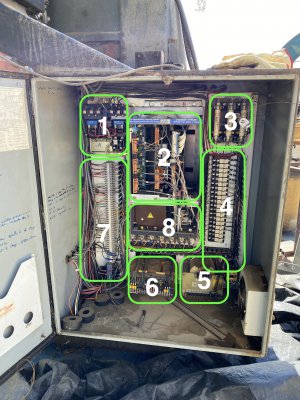- Joined
- May 2, 2021
- Messages
- 330
Thank you! I went at the knee with brute force - but I tackled the table with some care using some learned skills from the two stroke world. It was such a pleasure to see it come to life like that.That table is beautiful, not too often you find an old machine with a table that looks that good. Looks really good sitting in your shop, looks like it belongs there.
Some prior discussion on electronics occurred - I'm reposting below so its all in one place.That probably is the "spindle drive"
Let's see some pictures of the electric cabinet.
This is a week area for me (some reading this now are thinking - THATS NOT THE ONLY AREA!)
But before I get to that, might be helpful to refocus the general plan/ reasoning.
- Would like to have manual control. For my quick jobs in future - and I just plane like the idea of moving it manually
- *I see value in getting up and running quickly. Doesn't have to be pretty or full function. Keeps my momentum and starts building experience. Not to be underestimated.
- Have read a bit about the issue of ball screws being "too" easy to turn for manual. Assumed some form of table lock could help if needed.
Phase I - get it operational manually. Im ok with belts and cogs being exposed. Doesn't have to be pretty. Drill can be my power axis operation.
Phase II - CNC - with lower profile electronics. Volume of electronics seems enormous currently. Would like a lower profile solution.
Ok - now on to some specifics.
I'm going to order the DRO and a VFD - if I need it.
Not sure I do??
As far as the VFD, it looks like it is sized properly to run with the spindle motor on a 240V single phase supply.
The VFD has three conduits coming out of it. 2 go to the cabinet. 1 goes directly to the spindle motor...
Of the two that go in to the cabinet
- one has what appear to be low voltage wires that go to the main terminal strip (7) in pic below.
- The other has 4 heavy gauge red wires that go to the main disconnect and fuses - one to each. This appears to me to be the power source for the VFD.


Ok - let's revisit the path to phase I - 'cause I am now kinda lost.
Goal here is to have a workable manual mill.
Can be a little redneck out of the gate. I don't mind refining after I have operated a bit and understand it better.
So either nice handles I add - or I just turn the exposed cogs by hand or with drill (have been doing so for past few days).
Reasonably priced off shore DRO gives me my coordinates, plugs in to a 110 outlet on my wall.
Do we think this VFD could just be wired to have a 220 plug and... plug in giving me spindle power?
(I will need a handle for the quill lowering).
Secondarily - is there a means for me to test my servos with a bench power supply? I posted a pic above showing the tag on them for specs. I couldn't really make heads or tails of it.
Ok - re-posted from elsewhere - with a few extra's thrown in for your viewing pleasure.That probably is the "spindle drive"
Let's see some pictures of the electric cabinet.
Basic components are circled. I did that so I could get help identifying what's what.
Writing in red was from later posts that discussed what some components might be.
Below should be seen as general overview - to be confirmed.
#1 Reversing contactor for spindle motor. Remove, not needed. Has been replaced by the VFD
#2 Servo Drives. Keep, needs some slight modification to run on 120VAC single phase. I'll explain the 120VAC later
#3 Main disconnect & fuses. Keep
#4 Supplementary protection (fuses). Keep
#5 240/120 VAC Control Transformer. Keep.
(It was also proposed that it might be the servo drive transformer." I think that huge toroid feeds AC through the two black wires to #8, where it's rectified and smoothed with what looks like a gigantic cap to the right of the brown box. That transformer must weigh 40lbs.")
#5A Small contactor. Coolant pump relay?
#6 Servo drive power transformer. Remove, not needed.
(Some question on what this was)
#7 Terminal strip. Keep, always useful.
#7A Small transformer at bottom. Not sure what it's for, need further information.
(It was also proposed this might be the 120vac control transformer.)
#8 Ice cube relays. May be useful, depends on coil voltage.
#8A DC Power supply section for servo drives (behind the brown panel). See #2 above

Back of control panel:

Door of control panel when open:

main box better pics:


















